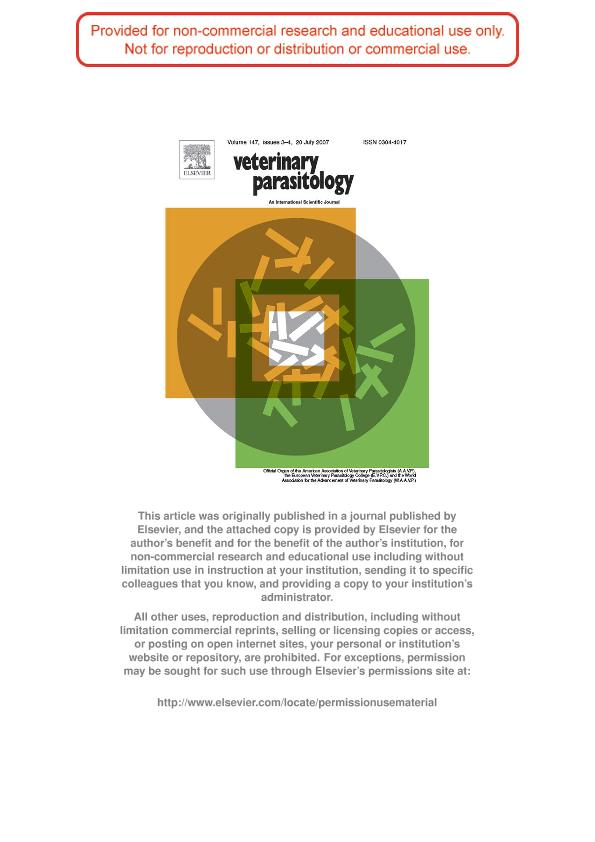Mostrar el registro sencillo del ítem
dc.contributor.author
Lifschitz, Adrian Luis

dc.contributor.author
Virkel, Guillermo Leon

dc.contributor.author
Ballent, Mariana

dc.contributor.author
Sallovitz, Juan Manuel

dc.contributor.author
Imperiale, Fernanda Andrea

dc.contributor.author
Pis, Alejandra
dc.contributor.author
Lanusse, Carlos Edmundo

dc.date.available
2020-04-28T19:14:14Z
dc.date.issued
2007-07
dc.identifier.citation
Lifschitz, Adrian Luis; Virkel, Guillermo Leon; Ballent, Mariana; Sallovitz, Juan Manuel; Imperiale, Fernanda Andrea; et al.; Ivermectin (3.15%) long-acting formulations in cattle: Absorption pattern and pharmacokinetic considerations; Elsevier Science; Veterinary Parasitology; 147; 3-4; 7-2007; 303-310
dc.identifier.issn
0304-4017
dc.identifier.uri
http://hdl.handle.net/11336/103807
dc.description.abstract
Ivermectin (IVM) is a broad-spectrum antiparasitic drug extensively used in veterinary medicine. The composition of the pharmaceutical preparation affects IVM absorption and its systemic availability. After the introduction of the first approved IVM formulation (propylene glycol/glycerol formal 60:40) used at 200 µg/kg, different pharmaceutical modifications have been assayed to extend IVM persistent endectocide activity. Recently, IVM 3.15% long-acting (IVM-LA) preparations to be administered at 630 µg/kg to cattle were introduced into the veterinary pharmaceutical market. The work reported here was designed to evaluate the comparative IVM absorption pattern and plasma concentration profiles obtained after subcutaneous administration of the classic pioneer IVM formulation (1%) and two different commercially available IVM-LA preparations (3.15 %) to cattle. Twenty-eight (28) Holstein heifers were divided in 4 experimental groups (n=7) and treated subcutaneously as follows: Group A: IVM 1% given at 200 µg/kg, Group B: IVM 1% administered at 630 µg/kg, Group C: IVM-LA (A) injected at 630 µg/kg and Group D: IVM-LA (B) given at 630 µg/kg. Blood samples were taken between 0.5 and 90 days post-treatment and IVM plasma concentrations were determined by HPLC with fluorescence detection. There were no differences in the persistence of IVM plasma concentrations after the administration of IVM 1 % formulation at the two used dose levels (200 and 630 µg/kg). Higher peak plasma concentration (Cmax) and shorter mean residence time (MRT) were obtained for IVM 1 % given at 630 µg/kg (Group B) compared to the treatments with both IVM-LA preparations. The IVM-LA (A) formulation showed a more extended absorption process than IVM-LA (B) preparation, which accounted for a longer persistence of detectable IVM plasma concentrations. The parasitological implications of the observed differences in peak plasma concentrations (Cmax values) and in the IVM concentration levels measured from day 20, and afterwards until day 90 post-treatment, between the different preparations assayed need to be elucidated. The characterization of the absorption patterns and kinetic behaviour obtained after injection of these novel long-acting formulations used at three times the therapeutic dose recommended for the classic IVM preparation in cattle is a further contribution to the field.
dc.format
application/pdf
dc.language.iso
eng
dc.publisher
Elsevier Science

dc.rights
info:eu-repo/semantics/openAccess
dc.rights.uri
https://creativecommons.org/licenses/by-nc-sa/2.5/ar/
dc.subject
IVERMECTIN
dc.subject
PHARMACOKINETICS
dc.subject
LONG ACTING PREPARATIONS
dc.subject
CATTLE
dc.subject.classification
Ciencias Veterinarias

dc.subject.classification
Ciencias Veterinarias

dc.subject.classification
CIENCIAS AGRÍCOLAS

dc.title
Ivermectin (3.15%) long-acting formulations in cattle: Absorption pattern and pharmacokinetic considerations
dc.type
info:eu-repo/semantics/article
dc.type
info:ar-repo/semantics/artículo
dc.type
info:eu-repo/semantics/publishedVersion
dc.date.updated
2020-04-17T14:39:01Z
dc.journal.volume
147
dc.journal.number
3-4
dc.journal.pagination
303-310
dc.journal.pais
Países Bajos

dc.journal.ciudad
Amsterdam
dc.description.fil
Fil: Lifschitz, Adrian Luis. Consejo Nacional de Investigaciones Científicas y Técnicas; Argentina. Universidad Nacional del Centro de la Provincia de Buenos Aires. Facultad de Ciencias Veterinarias. Departamento de Fisiopatología. Laboratorio de Farmacología; Argentina
dc.description.fil
Fil: Virkel, Guillermo Leon. Universidad Nacional del Centro de la Provincia de Buenos Aires. Facultad de Ciencias Veterinarias. Departamento de Fisiopatología. Laboratorio de Farmacología; Argentina. Consejo Nacional de Investigaciones Científicas y Técnicas; Argentina
dc.description.fil
Fil: Ballent, Mariana. Consejo Nacional de Investigaciones Científicas y Técnicas; Argentina. Universidad Nacional del Centro de la Provincia de Buenos Aires. Facultad de Ciencias Veterinarias. Departamento de Fisiopatología. Laboratorio de Farmacología; Argentina
dc.description.fil
Fil: Sallovitz, Juan Manuel. Universidad Nacional del Centro de la Provincia de Buenos Aires. Facultad de Ciencias Veterinarias. Departamento de Fisiopatología. Laboratorio de Farmacología; Argentina
dc.description.fil
Fil: Imperiale, Fernanda Andrea. Consejo Nacional de Investigaciones Científicas y Técnicas; Argentina. Universidad Nacional del Centro de la Provincia de Buenos Aires. Facultad de Ciencias Veterinarias. Departamento de Fisiopatología. Laboratorio de Farmacología; Argentina
dc.description.fil
Fil: Pis, Alejandra. Universidad Nacional del Centro de la Provincia de Buenos Aires. Facultad de Ciencias Veterinarias. Departamento de Fisiopatología. Laboratorio de Farmacología; Argentina
dc.description.fil
Fil: Lanusse, Carlos Edmundo. Consejo Nacional de Investigaciones Científicas y Técnicas; Argentina. Universidad Nacional del Centro de la Provincia de Buenos Aires. Facultad de Ciencias Veterinarias. Departamento de Fisiopatología. Laboratorio de Farmacología; Argentina
dc.journal.title
Veterinary Parasitology

dc.relation.alternativeid
info:eu-repo/semantics/altIdentifier/doi/http://dx.doi.org/10.1016/j.vetpar.2007.04.009
dc.relation.alternativeid
info:eu-repo/semantics/altIdentifier/url/https://www.sciencedirect.com/science/article/abs/pii/S0304401707002300
Archivos asociados
